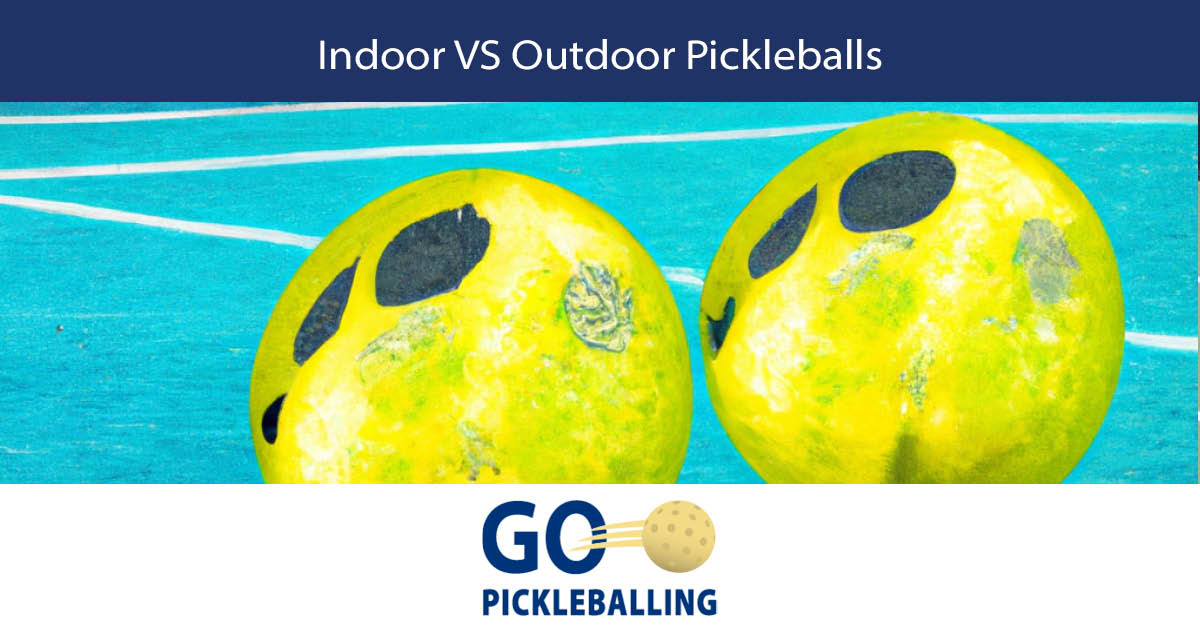When it comes to pickleball, the type of ball you choose can have a significant impact on your performance. Indoor pickleballs are ideal for indoor play, as they are lighter and easier to control. Outdoor pickleballs are better suited for outdoor play, as they are heavier and more durable. With that said, when it comes down to Indoor vs Outdoor Pickleballs it can be a personal preference, as some players may prefer one type of ball over the other.

How to Differentiate Between Indoor and Outdoor Pickleballs?
At first glance, indoor and outdoor pickleballs may seem quite similar, but upon closer inspection, their differences become evident. Here are five key distinctions that set them apart:
-
Number of Holes: Indoor pickleballs typically have 26 holes, whereas outdoor pickleballs boast 40 holes.
-
Hole Diameter: The holes in indoor pickleballs have wider diameters compared to those in outdoor pickleballs.
-
Weight: Outdoor pickleballs are generally heavier than their indoor counterparts.
-
Hardness: Outdoor pickleballs are made of harder plastic material, providing them with more bounce during play.
-
Durability: Due to their harder composition, outdoor pickleballs are more prone to cracking than the softer indoor pickleballs.
Number of Holes:
Indoor pickleballs typically have 26 holes, while outdoor pickleballs boast 40 holes. The variation in the number of holes affects the aerodynamics and flight characteristics of the balls. The additional holes in outdoor pickleballs allow for more air resistance, making them better suited for outdoor play where wind conditions may come into play. On the other hand, indoor pickleballs with fewer holes are designed to have a smoother flight path, ideal for indoor environments with controlled air circulation.
Hole Diameter:
The diameter of the holes in indoor and outdoor pickleballs is another noticeable difference. Indoor pickleballs have larger holes compared to outdoor ones. The larger holes in indoor balls contribute to a softer impact and slightly slower play, which is well-suited for indoor courts. In contrast, outdoor pickleballs have smaller holes that result in a faster pace and more bounce, making them suitable for outdoor play, where the surface is often rougher and requires a more robust ball.
Weight:
Outdoor pickleballs tend to be heavier than indoor ones. The added weight in outdoor balls gives them increased stability and resilience against wind and outdoor conditions. This weight difference allows outdoor pickleballs to maintain a more predictable trajectory and bounce, making them easier to control during outdoor play. Conversely, indoor pickleballs are lighter, enabling players to maneuver them with precision, especially during dinking and softer shots commonly seen in indoor play.
Hardness:
The hardness of the plastic material used in manufacturing pickleballs is another factor that distinguishes indoor from outdoor versions. Outdoor pickleballs are designed with a harder plastic composition, providing them with durability and resistance to wear and tear on rough outdoor surfaces. This hardness also contributes to their characteristic loud “pop” sound upon impact. Indoor pickleballs, on the other hand, are made from a softer plastic, which gives them a quieter and more controlled “thud” sound. The softer composition of indoor balls is preferred in order to minimize noise and preserve the indoor playing environment.
Durability:
Due to their harder plastic composition, outdoor pickleballs are more susceptible to cracking compared to the softer indoor ones. The rigid nature of outdoor balls allows for better performance on rough outdoor surfaces but comes at the cost of reduced flexibility and increased risk of damage. Conversely, the softer material used in indoor pickleballs provides increased durability and resilience, making them less prone to cracking or breaking, even during intense play.
Outdoor Pickleballs
Outdoor pickleballs are generally made of a harder material, such as plastic or composite. When it comes to hitting the ball you will receive more feedback and less forgiveness. This makes them heavier and more durable, which is ideal for outdoor play. Outdoor pickleballs also tend to be slightly larger than indoor pickleballs, making them easier to hit with a paddle. The harder material also helps increase bounce on an unpredictable playing surface. Most outdoor pickleballs will come with 40 smaller holes and be about 2.972 inches in diameter.

Outdoor Pickleball Balls
Eupboron 12 Pack Pickleball Balls Outdoor 40 Holes Training Pickle Ball
Indoor Pickleball Balls
Indoor Pickleballs
Indoor pickleballs are generally made of a softer plastic material, such as a soft composite or rubber compound. This makes them light and easier to control when hitting the ball and playing indoors. Indoor pickleballs also tend to be slightly smaller than outdoor pickleball, making them easier to hit with a paddle. The softer material also helps reduce bounce and provides a more consistent ball response. Most indoor pickleballs will come with 26 holes and be about 2.874 inches in diameter.
Indoor Pickleball Balls
Official Pickleball Specifications
To be an official pickleball they must meet specification for materials, Construction, Size, Weight, Bounce, Hardness, Design and Approval. The official Pickleball Specifications are listed below.
Approval
The tournament director will choose the tournament ball. The ball selected for play in any USAPA- or IFP-sanctioned tournament must be named on the official list of approved balls posted on the USAPA and IFP.
Size
The ball shall be 2.87 inches (7.29 cm) to 2.97 inches (7.54 cm) in diameter. The maximum out-of-round diameter variance shall not be greater than +/-0.020 inch (0.51 mm).
Weight
The ball shall weigh between 0.78 and 0.935 ounces (22.1 and 26.5 grams).
Bounce
The ball shall have a bounce of 30 to 34 inches (76.2 to 86.4 cm) to the top of the ball when dropped from a height of 78 inches (198.1 cm) onto a granite surface plate that is a minimum of 12 inches (30.5 cm) by 12 inches (30.5 cm) by 4 inches (10.2 cm). The test is to be performed at an ambient temperature of 75 to 80 degrees F (24 to 27 degrees C).
Construction
The ball shall be made of a durable material molded with a smooth surface and free of texturing. The ball will be one uniform color, except for identification markings. The ball may have a slight ridge at the seam, as long as it does not significantly impact the ball’s flight characteristics.
Hardness
The ball shall have a hardness of 40 to 50 on a Durometer D scale at an ambient temperature of 75 to 80 degrees F (24 to 27 degrees C).
Design
The ball shall have a minimum of 26 to a maximum of 40 circular holes, with spacing of the holes and overall design of the ball conforming to flight characteristics. The ball must have a manufacturer’s or supplier’s name or logo printed or embossed on it.
Final Thoughts
In conclusion, the main differences when looking at indoor vs outdoor pickleballs the difference lies in their construction, bounce and durability. Indoor pickleballs tend to be made of a softer material, have a lower bounce and are not as durable as outdoor pickleballs, which are made of a harder material, have a higher bounce and are more durable. Indoor pickleballs are designed for use on smooth, even indoor surfaces, whereas outdoor pickleballs are designed for use on a variety of outdoor surfaces, including concrete, asphalt, and grass. Furthermore, outdoor pickleballs are exposed to the elements, which can affect their performance, while indoor pickleballs are protected from the elements, providing a more consistent play.
In summary, indoor pickleballs are best suited for indoor courts and offer a softer, lower bounce, while outdoor pickleballs are best suited for outdoor courts and offer a harder, higher bounce. Pickleball Players should select the pickleball that best suits their playing environment and their personal preferences. Whether you’re playing indoors or outdoors, pickleball is a fun and exciting game that can be enjoyed by players of all ages and skill levels.
All products in this post can be found at Amazon.com.









